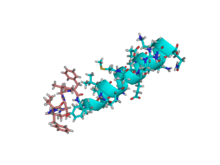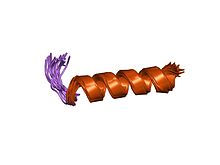Motilin
| Motilin | |
|---|---|

NMR solution structure of motilin in phospholipid bicellar solution.
|
|
| Identifiers | |
| Symbol | MLN |
| Entrez | 4295 |
| HUGO | 7141 |
| OMIM | 158270 |
| PDB | 1lbj |
| RefSeq | NM_001040109 |
| UniProt | P12872 |
| Other data | |
| Locus | Chr. 6 p21.3-p21.2 |
| Motilin/ghrelin | |||||||||
|---|---|---|---|---|---|---|---|---|---|

Structure of motilin in isotropic phospholipid bicellar solution.
|
|||||||||
| Identifiers | |||||||||
| Symbol | Motilin_ghrelin | ||||||||
| Pfam | PF04644 | ||||||||
| InterPro | IPR006738 | ||||||||
| SCOP | 1lbj | ||||||||
| SUPERFAMILY | 1lbj | ||||||||
| OPM superfamily | 154 | ||||||||
| OPM protein | 1lbj | ||||||||
|
|||||||||
| Available protein structures: | |
|---|---|
| Pfam | structures |
| PDB | RCSB PDB; PDBe; PDBj |
| PDBsum | structure summary |
Motilin is a 22-amino acid polypeptide hormone in the motilin family that, in humans, is encoded by the MLN gene.
Motilin is secreted by endocrine M cells (these are not the same as the microfold cells (M cells) that are in Peyer's patches) that are numerous in crypts of the small intestine, especially in the duodenum and jejunum. It is released into the general circulation in humans at about 100-min intervals during the inter-digestive state and is the most important factor in controlling the inter-digestive migrating contractions; and it also stimulates endogenous release of the endocrine pancreas. Based on amino acid sequence, motilin is unrelated to other hormones. Because of its ability to stimulate gastric activity, it was named "motilin". Apart from in humans, the motilin receptor has been identified in the gastrointestinal tracts of pigs, rats, cows, and cats, and in the central nervous system of rabbits.
Motilin was discovered by J.C. Brown when he introduced alkaline solution into duodena of dogs, which caused strong gastric contractions. Brown et al. predicted that alkali could either release stimulus to activate motor activity or prevent the secretion of inhibitory hormone. They isolated a polypeptide as a by-product from purification of secretin on carboxymethyl cellulose. They named this polypeptide “Motilin.”
Motilin has 22 amino acids and molecular weight of 2698. In extract from human gut and plasma, there are two basic forms of motilin. The first molecular form is the polypeptide of 22 amino acids. The second form, on the other hand, is larger and contains the same 22 amino acids as the first form but includes an additional carboxyl-terminus end.
...
Wikipedia
